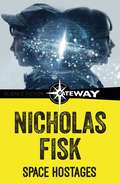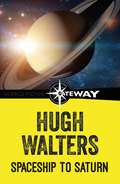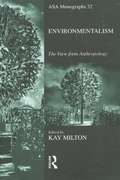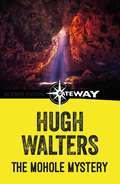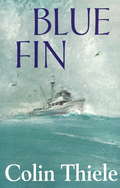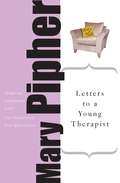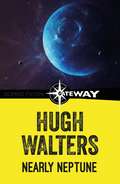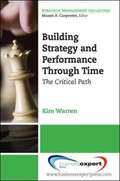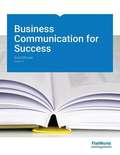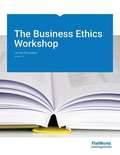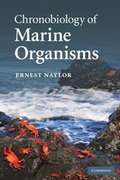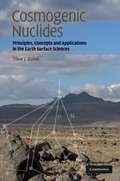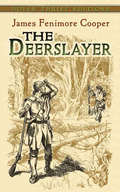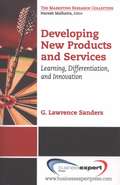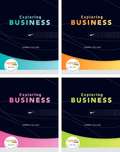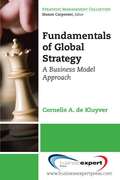- Table View
- List View
Space Hostages
by Nicholas FiskA crazed and dying Flight Lieutenant, nine village children, a top-secret spacecraft - all of them out of control and adrift in space! Someone must take charge. But who?Brylo has the brains, but not the personality, so it is the powerful young bully Tony who sets himself up as Captain - and steers the ship and its cargo of children towards new and horrifying dangers...
Spaceship to Saturn
by Hugh WaltersWhen the famous astronauts Chris Godfrey and his team are scheduled for a trip to Saturn, they are at first shocked to learn that they will be put into "deep freeze", a process called hypothermia, in order to make the long voyage possible. As on another voyage, the telepathic twins are enlisted for the project. Also frozen, they manage to avert disaster by sending warning signals even during their deep sleep. Extreme danger develops when Saturn's rings exert more gravitation than anticipated - pulling the spaceship into what seems certain destruction...
Environmentalism: The View from Anthropology (ASA Monographs #No.32)
by Kay MiltonLocated in a wide spectrum of current research and practice, from analyses of green ideology and imagery, enviromental law and policy, and local enviromental activism in the West to ethnographic studies of relationships between humans and their enviroments in hunter/gatherer societies, Enviromentalism: The View from Anthropology offers an original perspective on what is probably the best-known issue of the late twentieth century.It will be particularly useful to all social scientists interested in environmentalism and human ecology, to environmental policy-makers and to undergraduates, lecturers and researchers in social anthropology, development studies and sociology.
Heinlein in Dimension: A Critical Analysis
by Alexei PanshinFor over a quarter of a century, Robert A. Heinlein has been the acknowledged master of modern science fiction. His first few stories turned the field upside down, and set new standards of narrative and scientific excellence that few other authors have matched and none has surpassed. It is no credit to the critical fraternity that no extended attention has hitherto been paid to Heinlein. Alexei Panshin now offers the first full-length study of Heinlein's work and his place in contemporary science fiction. Like Damon Knight, Mr. Panshin works on the assumption that the ordinary standards of literature apply with full force to science fiction; a vaulting imagination does not excuse bad writing or foolish plotting. In addition there are criteria of narrative technique and scientific Plausibility that are peculiar to science fiction. Rigorously applying these standards, Mr. Panshin discusses Heinlein's fiction and analyzes its strengths and weaknesses; he traces the constants and the variables in Heinlein's interests and viewpoints; and he offers a suggestion as to the ultimate significance of Heinlein both in science fiction and in literature as a whole. Mr. Panshin has produced a study in depth that is neither adulatory nor carping, and is both comprehensive and readable. No doubt there will be other books written about Robert A. Heinlein, but we suspect that the present volume will be accepted as the definitive work for a long time to come.
The Mohole Mystery
by Hugh WaltersAfter their expedition to Saturn, Chris Godfrey and his friends were given the longest spell of leave they had ever had. Every day they expected to hear about their next assignment from Sir George Benson, Director of the United Nations Exploration Agency, but when they tried to get in touch with him they found it was impossible. Clearly something strange was going on.When Sir George finally reappeared he had a startling proposition for them. A new kind of expedition was to be launched, not into space but into the depths of the earth. The astronauts were about to become 'subterranuts'. Or rather one of them was, for only one man could enter the capsule which was to carry him down the Mohole, the borehole which had been drilled twenty-one miles into the earth, to end in a huge underground cavern...
Science, Politics and Gnosticism: Two Essays (The Collected Works Of Eric Voegelin Series #5)
by Eric VoegelinThis concise classic is the most accessible work in the canon of one of the 20th century'sgreatest political scientists. Eric Voegelin here contends that certain modern movements, including Positivism, Hegelianism, Marxism, and the "God is Dead" movement, are variants of the Gnostic tradition of antiquity. Highly provocative, this book is essential reading for students of modern politics, philosophy, and religion. <P><P>Hailed by the American Political Science Review as "one of the most distinguished interpreters to Americans of the non-liberal streams of European thought," Professor Voegelin was director of the Institute for Political Science at the University of Munich as well as professor of political science and lecturer at numerous universities in the United States and Europe. <P><P>With a new introduction by Ellis Sandoz, professor of political science at Lousiana State University and director of the Eric Voegelin Institute for American Renasissance Studies.
Blue Fin
by Robert Ingpen Colin ThieleAn Australian children's classic.Everyone in Port Lincoln thinks Snook Pascoe is a loser. People joke about his clumsiness; his teacher ridicules him and even his father, skipper of the tuna boat Blue Fin, is convinced that Snook will never amount to anything. After all, tuna fishing is a hard life for `real men?.When Snook is allowed, for once, to sail on Blue Fin he faces a terrifying disaster. A waterspout engulfs the ship, the deck is swept clean, the radio and rudder are wrecked, the engine is disabled, the crew is lost overboard and Snook?s father lies unconscious down below. Snook is on his own, far out to sea?COLIN THIELE, AC, was one of Australia?s most distinguished and popular writers for children. Colin's books have won numerous Australian and international awards and have been made into many classic films, TV series, plays and picture books. His bestsellers include the multi-award-winning STORM BOY.
Letters to a Young Therapist
by Mary PipherMary Pipher's groundbreaking investigation of America's "girl-poisoning culture," Reviving Ophelia, has sold nearly two million copies and established its author as one of the nation's foremost authorities on family issues. In Letters to a Young Therapist, Dr. Pipher shares what she has learned in thirty years as a therapist, helping warring families, alienated adolescents, and harried professionals restore peace and beauty to their lives. Letters to a Young Therapist gives voice to her practice with an exhilarating mix of storytelling and sharp-eyed observation. And while her letters are addressed to an imagined young therapist, every one of us can take something away from them. Long before "positive psychology" became a buzzword, Dr. Pipher practiced a refreshingly inventive therapy--fiercely optimistic, free of dogma or psychobabble, and laced with generous warmth and practical common sense. But not until now has this gifted healer described her unique perspective on how therapy can help us revitalize our emotional landscape in an increasingly stressful world. Whether she's recommending daily swims for a sluggish teenager, encouraging a timid husband to become bolder, or simply bearing witness to a bereaved parent's sorrow, Dr. Pipher's compassion and insight shine from every page of this thoughtful and engaging book.
Nearly Neptune
by Hugh WaltersChris Godfrey and his crew employ a new hypothermia technique which freezes them into unconsciousness for most of the journey, but when their ship's automatic transmitter contact with Earth ceases, the conclusion is that the expedition has met with disaster.
Building Strategy and Performance
by Kim WarrenThe fundamental challenge facing business leaders is to drive performance into the future--the dynamics of strategy. To tackle this effectively, they need a clear understanding of what causes performance to improve or deteriorate and what power they have to change this trajectory for the better. Without this understanding, they risk making poor choices about their future--failing to exploit promising opportunities, pursuing unachievable aims, or falling victim to competitive and other threats. Building Strategy and Performance Through Time sets the agenda for building business strategy in powerful, actionable, and accessible terms. It gives executives clear frameworks for answering three fundamental questions: * Why is our business performance following its current path? * Where is it going if we carry on as we are? * How can we design a robust strategy to transform this future? The existing strategy tools most widely used help guide management's choices about where to compete--which customers to serve, with what products and services, and how to deliver those products and services to those customers effectively and profitably. While this choice is important, it is not often changed in any fundamental way; having found a reasonably strong and profitable position on these issues, few firms will, or should, set off in a new direction. But there is still much to be done to deliver that strategy, powerfully and sustainably over time. Many decisions need to be made, continually and holistically, across all functions of the business and adapted as conditions change from month to month and year to year. Pricing, product development, marketing, hiring, service levels, and other decisions cannot be made in isolation but must take into account other choices being made, elsewhere and at different times. Building Strategy and Performance Through Time explains a reliable, practical method, known as strategy dynamics, that creates a living picture of how an enterprise actually works and delivers performance. This picture shows exactly where the levers are that management controls and how to choose what to do, when, and how much, to accomplish your specific goals. It shows, too, how the same approach can be used to defeat competitors, cope with other outside forces, and keep delivering performance.
Business Communication for Success
by Scott McleanThis book is suited for Business Communication courses, but is also appropriate for Business English, Business Presentation, Professional Communication courses. Scott McLean brings his authoring expertise to this new communications textbook. Scott has authored textbooks in the areas of Speech Communication, Interpersonal Communication and Public Speaking. Business Communications for Success benefits from Scott's extensive understanding of how students learn the art of effective communication. Students are provided ample opportunity to engage with the concepts, vocabulary and models covered in the text, including role-playing exercises, journal writings, case studies, small-group activities, games, and self-assessment activities.
The Business Ethics Workshop v 1.0
by James BrusseauOn a good day in the business ethics classroom discussion charges forward; students have read the assigned case study, they're engaged by the conflict and want to work through it. Then, there's a bad day: students didn't bother to do the reading and the hour sags listlessly. The key to going the first way is case studies that students want to read, and The Business Ethics Workshop by James Brusseau provides them with reality and engagement. Reality: No stilted and contrived stories about Steve Smith and Jane Jones. Excerpts from blogs and newspapers bring the weight--and provocation--of the world as it's actually happening to the classroom.
Business Law and the Legal Environment
by Don Mayer Daniel M. Warner George J. Siedel Jethro K. LiebermanMayer, Warner, Siedel and Lieberman's Business Law and the Legal Environment is an up-to-date textbook with comprehensive coverage of legal and regulatory issues -- and organized to permit instructors to tailor the materials to their particular approach. The authors take special care to engage students by relating law to everyday events with which they are already familiar with their clear, concise and readable style. Business Law and the Legal Environment provides students with context and essential concepts across the entire range of legal issues with which managers and business executives must grapple. The texts provide the vocabulary and legal acumen necessary for business people to talk in an educated way to their customers, employees, suppliers, government officials -- and to their own lawyers.
Chronobiology of Marine Organisms
by Ernest NaylorDo intertidal organisms simply respond to the rise and fall of tides, or do they possess biological timing and navigation mechanisms that allow them to anticipate when conditions are most favourable? How are the patterns of growth, development and reproduction of some marine plants and animals related to changes in day-length or to phases of the moon? The author describes how marine organisms, from single cells to vertebrates, on sea shores, in estuaries and in the open ocean, have evolved inbuilt biological clockwork and synchronisation mechanisms which control rhythmic processes and navigational behaviour, permitting successful exploitation of highly variable and often hostile environments. Adopting a hypothesis-testing and experimental approach, the book is intended for undergraduate and postgraduate students of marine biology, marine ecology, animal behaviour, oceanography and other biological sciences and also as an introduction for researchers, including physiologists, biochemists and molecular biologists entering the field of chronobiology.
College Success
by Bruce Beiderwell Linda Tse Thomas J. Lochhaas Nicholas B. DekanterCollege Success takes a fresh look at what it means, in today's world, with today's students, to be successful in college. Although many of the topics included--from study skills to personal health, from test-taking to managing time and money--will look familiar to those who have used student success texts that have been around for many editions, College Success takes a new approach. The focus is on realistic, practical tools for the students who need them. This is a book designed, frankly, for students who may have difficulty with traditional college texts. The style is direct and to the point. Information is presented concisely and as simply as possible. This is not a weighty tome that discusses student success--this is a manual for doing it. College student demographics have changed considerably in recent decades. More than a third of all students enroll not directly from high school but after a delay of some years. More students are working and have families. More students come from varied ethnic and cultural backgrounds. More students are the first in their family to attend college. More students have grown up with electronic media and now read and think in ways different from the previous generation. With these and so many other cultural changes, more students are not well prepared for a college education with the study skills and life skills they need to become successful students. For each student to get the most out of College Success and their college experience they must understand who they are as it relates to college. To that end, in every chapter students explore themselves, because success starts with recognizing your own strengths and weaknesses. Students make their own goals based on this self-assessment, determining what success in college really means for them as individuals. Interactive activities then help students learn the choices available to them and the possibilities for improving their skills. Skills are presented in step-by-step processes, tips for success in manageable highlighted displays. Most important, students always see the value of what they are reading--and how they can begin to apply it immediately in their own lives. College Success is intended for use in Freshmen Orientation, Study Skills or Student Success courses. A 2009 study revealed that currently nationwide, 34% of college freshmen do not return to their college for their sophomore year. This book is designed to help change that.
Cosmogenic Nuclides
by Tibor J. DunaiThis is the first book to provide a comprehensive and state-of-the-art introduction to the novel and fast-evolving topic of in-situ produced cosmogenic nuclides. It presents an accessible introduction to the theoretical foundations, with explanations of relevant concepts starting at a basic level and building in sophistication. It incorporates, and draws on, methodological discussions and advances achieved within the international CRONUS (Cosmic-Ray Produced Nuclide Systematics) networks. Practical aspects such as sampling, analytical methods and data-interpretation are discussed in detail and an essential sampling checklist is provided. The full range of cosmogenic isotopes is covered and a wide spectrum of in-situ applications are described and illustrated with specific and generic examples of exposure dating, burial dating, erosion and uplift rates and process model verification. Graduate students and experienced practitioners will find this book a vital source of information on the background concepts and practical applications in geomorphology, geography, soil-science, and geology.
The Deerslayer: Or, The First War-path. A Tale... (Dover Thrift Editions)
by James Fenimore CooperOn his first "warpath" in New York's Lake Otsego during the French and Indian Wars, the courageous Natty Bumppo — one of American literature's noblest heroes — is honor-bound to rescue a trapper and his family attacked by Iroquois Indians. Accompanied by his loyal Mohican friend, Chingachgook, the great frontiersman becomes embroiled in a bloody battle of capture and escape.Originally published in 1841, The Deerslayer is one of James Fenimore Cooper's legendary "Leatherstocking Tales" — heart-pounding narratives of adventure in the vast wilderness and desolate prairies of eighteenth-century America. Acclaimed by D. H. Lawrence as "the loveliest and best" of Cooper's works, The Deerslayer recaptures the danger and excitement of frontier life in the New World.
Developing New Products and Services
by G. Lawrence SandersThe focus of the book is on the up-front activities and ideas for new product and service development. A central theme of this book is that there is, or should be, a constant struggle going on in every organization, business, and system between delivering feature-rich versions of products and services using extravagant engineering and delivering low-cost versions of products and services using frugal engineering. Delivering innovative products is accomplished by an endless cycle of business planning, creative and innovative insight, and learning-about and learning-by-doing activities. A number of powerful concepts and tools are presented in the book to facilitate new product development. For example, three templates are presented that facilitate new product and service development. The FAD (features, attributes, and design) template is used to identify the features and attributes that can be used for product and service differentiation. The Ten-Ten planning process contains two templates: an Organizational and Industry Analysis template and the Business Plan Overview template. These two templates coupled with the FAD template can be used to develop a full-blown business plan. Entrepreneurship, technology and product life cycles, product and service versioning, product line optimization, creativity, lock-in real options, business valuation, and project management topics are also covered.
Economics: Theory Through Applications
by Russell Cooper A. Andrew JohnThis textbook, Economics: Theory Through Applications, centers around student needs and expectations through two premises: ... Students are motivated to study economics if they see that it relates to their own lives. ... Students learn best from an inductive approach, in which they are first confronted with a problem, and then led through the process of solving that problem. Many books claim to present economics in a way that is digestible for students; Russell and Andrew have truly created one from scratch. This textbook will assist you in increasing students' economic literacy both by developing their aptitude for economic thinking and by presenting key insights about economics that every educated individual should know.
Exploring Business
by Karen CollinsCollins is the only Introduction to Business book to teach students the topics of business through an in-depth study of a single company--Nike. How do you show your students the relationships between what they are learning in the classroom and what happens in the real business world? What happens when your students don't see the connections between the theory they are learning in the classroom and what is happening in the real business world?
Fundamentals of Global Strategy
by Cornelis A. de KluyverThis book looks at the opportunities and risks associated with staking out a global competitive presence and introduces the fundamentals of global strategic thinking. We define crafting a global strategy in terms of change: how a company should change and adapt its core (domestic) business model to achieve a competitive advantage as it expands globally. The conceptual framework behind this definition has three fundamental building blocks: a company's core business model, the various strategic decisions a company needs to make as it globalizes its operations, and a range of globalization strategies for creating a global competitive advantage. A business model is defined in terms of four principal components: (a) market participation--who its customers are, how it reaches them and relates to them; (b) the value proposition--what a company offers its customers; (c) the supply chain infrastructure--with what resources, activities and partners it creates its offerings; and finally, (d) its management model--how it organizes and coordinates its operations. Globalization requires a company to make strategic decisions about each component of the business model. Market participation decisions include choosing which specific markets or segments to serve, domestically or abroad; what methods of distribution to use to reach target customers; and how to promote and advertise the value proposition. Globalization decisions about the value proposition touch the full range of tangible and intangible benefits a company provides to its customers (stakeholders). Decisions about a company's value chain infrastructure deal with such questions as, What key internal resources and capabilities has the company created to support the chosen value proposition and target markets? What partner network has it assembled to support the business model? How are these activities organized into an overall, coherent value creation and delivery model? Finally, strategic decisions about the global management dimension are concerned with a company's choices about a suitable global organizational structure and decision-making process. We use Pankaj Ghemawat's well-known "AAA Triangle" framework to define three generic approaches to global value creation. Adaptation strategies seek to increase revenues and market share by tailoring one or more components of a company's business model to suit local requirements or preferences. Aggregation strategies focus on achieving economies of scale or scope by creating regional or global efficiencies; they typically involve standardizing a significant portion of the value proposition and grouping together development and production processes. Arbitrage is about exploiting economic or other differences between national or regional markets, usually by locating separate parts of the supply chain in different places.
General Chemistry
by Bruce Averill Patricia EldredgeThe overall goal of the authors with General Chemistry: Principles, Patterns, and Applications was to produce a text that introduces the students to the relevance and excitement of chemistry. Although much of first-year chemistry is taught as a service course, Bruce and Patricia feel there is no reason that the intrinsic excitement and potential of chemistry cannot be the focal point of the text and the course. So, they emphasize the positive aspects of chemistry and its relationship to students' lives, which requires bringing in applications early and often. In addition, the authors feel that many first year chemistry students have an enthusiasm for biologically and medically relevant topics, so they use an integrated approach in their text that includes explicit discussions of biological and environmental applications of chemistry. Topics relevant to materials science are also introduced to meet the more specific needs of engineering students.
Information Systems: A Manager's Guide to Harnessing Technology version 1.2
by John GallaugherInformation Systems: A Manager's Guide to Harnessing Technology V1.2 is intended for use in undergraduate and/or graduate courses in Management Information Systems and Information Technology. Version 1.2 of John's book retains the same structure and theory of version 1.1, but refreshes key statistics, examples, and brings case material up to date (vital when covering firms that move as fast as Facebook, Google, and Netflix). Adopting version 1.2 guarantees your students will have the most current text on the market, drawing real and applicable lessons from material that will keep your class offerings current and accessible.
Information Systems: A Manager's Guide to Harnessing Technology version 1.3
by John GallaugherInformation Systems: A Manager's Guide to Harnessing Technology V 1.3 is intended for use in undergraduate and/or graduate courses in Management Information Systems and Information Technology. Version 1.3 of John's book retains the same structure and theory of version 1.1 and V 1.2, but refreshes key statistics, examples, and brings case material up to date (vital when covering firms that move as fast as Facebook, Google, and Netflix). For example; the Netflix chapter - Updates address the major changes impacting Netflix in 2011, including the response to the firm's pricing changes, the failed Qwikster service split, recent developments impacting the streaming and DVD-by-mail businesses, a comparison table detailing the stark differences between the firm's two offerings (DVD & streaming), updated statistics, learning objectives, and additional exercises and updates to the Google chapter - Updated text/images for currency, additional sub-sections on the firm's Google+ launch and the acquisition of Motorola Mobility. Adopting version 1.3 guarantees your students will have the most current text on the market, drawing real and applicable lessons from material that will keep your class offerings current and accessible.
Information Systems: A Manager's Guide to Harnessing Technology - Version 1.1
by John GallaugherInformation Systems: A Manager's Guide to Harnessing Technology is intended for use in undergraduate and/or graduate courses in Management Information Systems and Information Technology. One of BusinessWeek's "Professors of the Year", John Gallaugher of Boston College, brings you a brand new Management Information Systems textbook that teaches students how he or she will experience IS from a Managers perspective first hand through interesting coverage and bleeding-edge cases. Get involved with John's community by visiting and subscribing to his blog, The Week In Geek, where courseware, technology and strategy intersect and joining his Ning IT Community site where you can get more resources to teach Information Systems. Shockingly, at a time when technology regularly appears on the cover of every major business publication, students find IS among the least appealing of management disciplines. The teaching approach in Information Systems: A Manager's Guide to Harnessing Technology can change this. The text offers a proven approach that has garnered student praise, increased IS enrollment, and engaged students to think deeper and more practically about the space where business and technology meet. Every topic is related to specific business examples, so students gain an immediate appreciation of its importance. Rather than lead with technical topics, the book starts with strategic thinking, focusing on big-picture issues that have confounded experts but will engage students. And while chapters introduce concepts, cases on approachable, exciting firms across industries further challenge students to apply what they've learned, asking questions like: Why was NetFlix able to repel Blockbuster and WalMart? How did Harrah's Casino's become twice as profitable as comparably-sized Caesar's, enabling the former to acquire the latter? How does Spain's fashion giant Zara, a firm that shuns the sort of offshore manufacturing used by every other popular clothing chain, offer cheap fashions that fly off the shelves, all while achieving growth rates and profit margins that put Gap to shame? What's an IPO and can a technology alternative push out investment bankers and insiders to the benefit of entrepreneurs and small investors? Why is Google more profitable than Disney? Is Facebook really worth $15 billion? The Information Systems course and discipline have never seemed more relevant, more interesting, and more exciting. Gallaugher's textbook can help teachers make students understand why.
